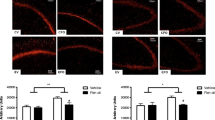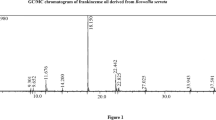Abstract
Epilepsy prevails to be a neurological disorder in anticipation of safer drugs with enhanced anticonvulsant efficacy as presently available drugs fails to offer adequate control of epileptic seizures in about one-third of patients. The objective of this study was to evaluate the effect of Trichosanthes tricuspidata methanolic extract (TTME) against epilepsy mediated oxidative stress in pilocarpine induced mice. Intraperitonial administration of pilocarpine (85 mg/kg) induced seizure in mice was assessed by behavior observations, which is significantly (p < 0.05) reduced by TTME (100 and 200 mg/kg; i.p) in a dose dependant manner, similar to diazepam. Seizure was accompanied by significant increase in lipid peroxidation and the hippocampal nitrite content in pilocarpine group when compared with control. Moreover, the antioxidant enzymes superoxide dismutase, catalase and glutathione levels were decreased in pilocarpine administered groups. TTME administration attenuated oxidative damage as evident by decreased lipid oxidative damage and nitrite–nitrate content and restored the level of enzymatic antioxidant defenses in hippocampus. Involvement of free radicals during epilepsy is further confirmed by histopathological analysis which showed the loss of neuronal cells in hippocampus CA1 and CA3 pyramidal region. Our findings strongly support the hypothesis that TTME has anticonvulsant activity accompanied with the strong antioxidant potential plays a crucial role in reducing the oxidative stress produced by seizure.









Similar content being viewed by others
Abbreviations
- NMDAR:
-
N-methyl-d-aspartate
- ADE:
-
Antiepileptic drugs
- EDTA:
-
Ethylenediaminetetraacetic acid
- SOD:
-
Superoxide dismutase
- CAT:
-
Catalase
- GSH:
-
Reduced glutathione
- DTNB:
-
5,5′-Dithiobis-(2-nitrobenzoic acid)
- TBARS:
-
Thiobarbituric-acid-reacting substances
- MDA:
-
Melandialdehyde
- CA1:
-
Cornu ammonis
- GABA:
-
Gamma-aminobutyric acid
References
Frantseva MV, Perez VJL, Hwang PA et al (2000) Free radical production correlates with cell death in an in vitro model of epilepsy. Eur J Neurosci 12:1431–1439
Guo J, Xue C, Duan Jin-ao, Qian D, Tang Y, Yi Y (2011) Anticonvulsant, antidepressant-like activity of Abelmoschus manihot ethanol extract and its potential active components in vivo. Phytomedicine 18:1250–1254
Gulati K, Ray A, Pal G, Vijayan VK (2005) Possible role of free radicals in theophylline induced seizures in mice. Pharmacol Biochem Behav 82:241–245
Gupta YK, Kumar VMH, Srivastava AK (2003) Effect of Centella asiatica on pentylenetetrazole-induced kindling, cognition and oxidative stress in rats. Pharmacol Biochem Behav 74:579–585
Hort J, Brozek G, Komárek V, Langmeier M, Mares P (2000) Interstrain differences in cognitive functions in rats in relation to status epilepticus. Behav Brain Res 112(2):77–83
Tome AR, Feng D, Freitas RM (2010) The effects of alpha-tocopherol on hippocampal oxidative stress prior to in pilocarpine-induced seizures. Neurochem Res 35(4):580–587
Shin EJ, Jeong JH, Chung YH, Kim WK, Ko KH, Bach JH, Hong JS, Yoneda Y, Kim HC (2011) Role of oxidative stress in epileptic seizures. Neurochem Int 59(2):122–137
Konar A, Shah N, Singh R, Saxena N, Kaul SC, Wadhwa R, Thakur MK (2011) Protective role of Ashwagandha leaf extract and its component with an one on scopolamine-induced changes in the brain and brain-derived cells. PLoS One 6:1–11
Koppula S, Kumar H, More SV, Kim BW, Kim IS, Choi DK (2012) Recent advances on the neuroprotective potential of antioxidants in experimental models of Parkinson’s disease. Int J Mol Sci 13:10608–10629
Mahendran S, Thippeswamy BS, Veerapur VP, Badamib S (2011) Anticonvulsant activity of embelin isolated from Embelia ribes. Phytomedicine 18:186–188
Kanchanapoom T, Ryoji K, Yamasaki K (2002) Cucurbitane, hexanorcucurbitane and octanorcucurbitane glycosides from fruits of Trichosanthes tricuspidata. Phytochemistry 59:215–228
Duvey BK, Goyel R, Parashar B, Verma D, Dhameja H, Sharma D (2012) Trichosanthes tricuspidata: exploration of its medicinal value. Review article. Asian J Pharm Tech 2:26–28
Manivel K, Rajangam P, Muthusamy K, Somasundaram R (2011) Evaluation of anti-pyretic effect of Trichosanthes tricuspidata Linn on albino rats. IJPRBA 2(4):718–1720
Nithiya P, Mohan K (2009) Antioxidative effect of Trichosanthes tricuspidata root extract on sildenafil induced migraine in albino mice. Pharmacogn Res 1(6):402–405
Halimi M, Vahedi H, Lari J, Nasrabadi M (2011) Chemical composition of n-hexane extract of the fruit from Bereberise integrrima of Iran. Der Pharmacia Sinica 2:27–30
Nezhadali A, Parsa M (2010) Study of volatile compounds in Artemesia absinthium from Iran using HS/SPME/GC/MS. Adv Appl Sci Res 1:174–179
Lorke D (1983) A new approach to practical acute toxicity testing. Arch Toxicol 54:275–287
Holzmann I, Filho CV, Mora TC, Caceres A, Martinez JV, Cruz SM, De Souza MM (2011) Evaluations of behavioral and pharmacological effects of hydroalcoholic extract of Valeriana prionophylla stand from Guatemala. Evid Based Complement Alternat Med 1–9. doi:10.1155/2011/312320
Galani VJ, Patel BG (2010) Effect of hydroalcoholic extract of Sphaeranthus indicus against experimentally induced anxiety, depression and convulsions in rodents. Int J Ayurveda Res 1:87–92
Salahdeen HM, Yemitan OK (2006) Neuropharmacological effects of aqueous leaf extract of Bryophyllum pinnatum in mice. Afr J Biol Med Res 9:101–107
Racine R, Okujava V, Chipashvili S (1972) Modification of seizure activity by electrical stimulation 3 mechanisms. Electroencephalogr Clin Neurophysiol 32:295–299
Lowry H, Rosebrough NJ, Farr AL, Randall RJ (1951) Protein measurements with the follin phenol reagent. J Biol Chem 193:265–275
Kakkar P, Dos B, Viswnathan PN (1984) A modified spectrophotometric assay of superoxide dismutase. Indian J Biochem 21:130–132
Sinha KA (1972) Colorimetric assay of catalase. Anal Biochem 47:389–394
Oliveira AA, Almeida JPC, Freitas RM, Nascimento VS, Aguiar LMV, Junior HVN, Fonseca FN, Viana GSB, Sousa FCF, Fonteles MMF (2007) Effects of levetiracetam in lipid peroxidation level, nitrite–nitrate formation and antioxidant enzymatic activity in mice brain after pilocarpine-induced seizures. Cell Mol Neurobiol 27:395–406
Huong NTT, Malsumato K, Kasai R et al (1998) In vitro antioxidant activity of Vietnamese ginseng saponin and its components. Biol Pharm Bull 21:978–981
Green LC, Tannenbaum SR, Goldman P (1981) Nitrate synthesis in the germ free and conventional rat. Science 212:56–58
Radenovic L, Selakovic V (2005) Differential effects of NMDA and AMPA/kainate receptor antagonists on nitric oxide production in rat brain following intra hippocampal injection. Brain Res Bull 67:133–141
Agar E, Demir S, Amanvermez R, Bosnak M, Ayyildiz M, Celik C (2000) The changes in lipid peroxidation and GSH levels in the cerebellum of rats induced by ethanol consumption are prevented by vitamin E. Neurosci Res Commun 27:191–197
Kozan R, Ayyildiz M, Yildirim M, Agar E (2009) The effect of alpha-tocopherol in the acute ethanol intake and its withdrawal on penicillin-induced epilepsy. Acta Neurobiol Exp 69:177–188
Jimenez A, Meckes M, Alvarez V (2005) Secondary metabolites from Chamaedora tepejilote (Palmae) are active against Mycobacterium tuberculosis. Phytother Res 19:320–322
Costa JP, Ferreira PB, De Sousa DP, Jordan J, Fretias RM (2012) Anticonvulsant effect of phytol in a pilocarpine model in mice. Neurosci Lett 523(2):115–118
Silva MIG, Silva MA, Aquino Neto DMR, Moura BA, De Sousa HL, De Lavor EP, De Vasconcelos PF, Macedo DS, De Sousa DP, Vasconcelos SM, De Sousa FC (2009) Effects of isopulegol on pentylenetetrazol-induced convulsions in mice possible involvement of GABAergic system and antioxidant activity. Fitoterapia 80:506–513
Chebib M, Johnston AR (2000) GABA-activated ligand gated ion channels: medicinal chemistry and molecular biology. J Med Chem 43:1427–1447
Krasowski MD, Jenkins A, Flood P, Kung AY, Hopfinger AJ, Harrison NL (2001) General anesthetic potencies of a series of propofol analogs correlate with potency for potentiation of ç-aminobutyric acid (GABA) current at the GABAA receptor but not with lipid solubility. J Pharmacol Exp Ther 297:338–351
Shin HJ, Lee JY, Son E, Lee DH, Kim HJ, Kang SS, Cho GJ, Choi WS, Roh GS (2007) Curcumin attenuates the kainic acid-induced hippocampal cell death in the mice. Neurosci Lett 416:49–54
Hui KM, Huen Michael SY, Wang Hong Y, Zheng H, Sigel E, Baur R, Ren H, Li ZW, Wong JTF, Xue H (2002) Anxiolytic effect of wogonin, a benzodiazepine receptor ligand isolated from Scutellaria baicalensis Georgi. Biochem Pharmacol 64:1415–1424
Hanrahan JR, Chebib M, Johnston GAR (2011) Flavonoid modulation of GABA receptors. Br J Pharmacol 163:234–245
Vignes M, Maurice T, Lante F, Nedjar M, Thethi K, Guiramand J, Recasens M (2006) Anxiolytic properties of green tea polyphenol (−)-epigallocatechin gallate (EGCG). Brain Res 1110:102–115
Singh B, Singh D, Goel RK (2012) Dual protective effect of Passiflora incarnata in epilepsy and associated post-ictal depression. J Ethnopharmacol 139:273–279
Shukitt-Hale B, Lau FC, Carey AN, Galli RL, Spangler EL, Ingram DK, Joseph JA (2008) Blueberry polyphenols attenuate kainic acid-induced decrements in cognition and alter inflammatory gene expression in rat hippocampus. Nutr Neurosci 11(4):172–182
Czuczwar SJ, Patsalos PN (2001) The new generation of GABA enhancers potential in the treatment of epilepsy. CNS Drugs 5(5):339–350
Ahmad S, Yousuf S, Ishrat T, Khan MB, Bhatia K, Fazli IS, Khan JS, Ansari NS, Islam F (2006) Effect of dietary sesame oil as antioxidant on brain hippocampus of rat in focal cerebral ischemia. Life Sci 79:1921–1928
Zhang Y, Milatovic D, Aschner M, Feustel PJ, Kimelberg HK (2007) Neuroprotection by tamoxifen in focal cerebral ischemia is not mediated by an agonist action at estrogen receptors but is associated with antioxidant activity. Exp Neurol 204:819–827
Aboul Ezz HS, Khadrawy YA, Noor NA (2011) The neuroprotective effect of curcumin and Nigella sativa oil against oxidative stress in the pilocarpine model of epilepsy: a comparison with valproate. Neurochem Res 36:2195–2204
Zafar KS, Siddiqui A, Sayeed I, Ahmad M, Saleem S, Islam F (2003) Protective effect of adenosine in rat model of Parkinson’s disease: neurobehavioral and neurochemical evidences. J Chem Neuroanat 26:143–151
Nazıroglu M, Akay MB, Celik O, Yıldırım MI, Balcı E, Yurekli VA (2013) Capparis ovata modulates brain oxidative toxicity and epileptic seizures in pentylentetrazol-induced epileptic rats. Neurochem Res. doi:10.1007/s11064-013-0978-3
Jeyadevi R, Sivasudha T, Rameshkumar A, Harnly JM, Lin LZ (2013) Phenolic profiling by UPLC–MS/MS and hepatoprotective activity of Cardiospermum halicacabum against CCl4 induced liver injury in Wistar rats. J Funct Foods 5(1):289–298
Acharya MM, Hattiangady B, Shetty AK (2008) Progress in neuroprotective strategies for preventing epilepsy. Prog Neurobiol 84:363–404
Freitas RM (2009) Investigation of oxidative stress involvement in hippocampus in epilepsy model induced by pilocarpine. Neurosci Lett 462:225–229
Kamal SM (2012) Combination of valproate and paroxetine in mice exposed to picrotoxin. Int J Nanomed 7:2583–2589
Kovacs R, Rabanus A, Otahal J et al (2009) Endogenous nitric oxide is a key promoting factor for initiation of seizure-like events in hippocampal and entorhinal cortex slices. J Neurosci 29:8565–8577
Forman HJ, Zhang H, Rinna A (2009) Glutathione: overview of its protective roles, measurement and biosynthesis. Mol Aspects Med 30:1–12
Price TO, Uras F, Baks WA, Ercal N (2006) A novel antioxidant N-acetylcysteine amide prevents gp120-and Tat-induced oxidative stress in brain endothelial cells. Exp Neurol 201:193–202
Halliwell B (2001) Role of free radicals in the neurodegenerative diseases. Therapeutic implications for antioxidant treatment. Drugs Aging 18:685–716
Shobana C, Kumar RR, Sumathi T (2012) Alcoholic extract of Bacopa monniera Linn. Protects against 6-hydroxydopamine-induced changes in behavioral and biochemical aspects: a pilot study. Cell Mol Neurobiol. doi:10.1007/s10571-012-9833-3
Dillioglugil MO, Kir HM, Demir C, Ilbay G, Sahin D, Dillioglugil O, Bambal G, Mekik H, Ates N (2010) Effect of pentylenetetrazole and sound stimulation induced single and repeated convulsive seizures on the MDA, GSH and NO levels, and SOD activities in rat liver and kidney tissues. Brain Res Bull 83:356–359
Militao GC, Ferreira PM, De Freitas RM (2010) Effects of lipoic acid on oxidative stress in rat striatum after pilocarpine-induced seizures. Neurchem Int 56:16–20
Hansen JT, Koeppen BM (2002) Atlas of neuroanatomy and neurophysiology. Selections from the Netter Collection of Medical Illustrations. Special ed. Icon Custom Communications, USA
Acknowledgments
The authors are thankful to Dr. G. Archunan, Assistant professor, Department of Animal Biotechnology, Bharathidasan University, Tiruchirappalli for helping us in behavior parameters of the animals. The authors are also thankful to Mr. Ajay Kumar, AIRF, JNU, New Delhi for his valuable contribution in carrying out analysis and interpretation of GC/MS data. Finally we thank DST-FIST for providing instrument facilities.
Author information
Authors and Affiliations
Corresponding author
Rights and permissions
About this article
Cite this article
Smilin Bell Aseervatham, G., Sivasudha, T., Suganya, M. et al. Trichosanthes tricuspidata Modulates Oxidative Toxicity in Brain Hippocampus Against Pilocarpine Induced Status Epilepticus in Mice. Neurochem Res 38, 1715–1725 (2013). https://doi.org/10.1007/s11064-013-1075-3
Received:
Revised:
Accepted:
Published:
Issue Date:
DOI: https://doi.org/10.1007/s11064-013-1075-3




